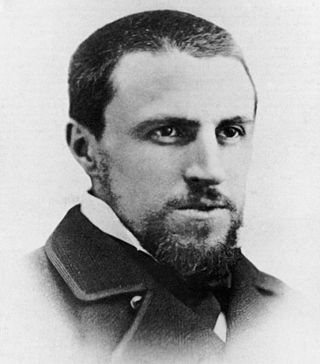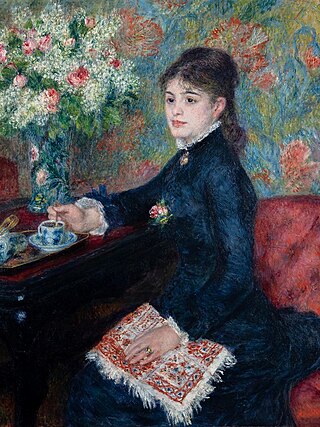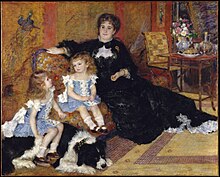Background
French publisher Georges Charpentier (1846-1905), a wealthy patron of the naturalist genre of writers, particularly French author Émile Zola, was an early advocate and collector of Impressionist works. He married Marguerite Lemonnier in 1871. Georges began buying paintings by French artist Pierre-Auguste Renoir (1841–1919) in the 1870s. [1] Charpentier purchased two landscapes and one portrait by Renoir at the second Impressionist exhibition in 1875, including The angler (Le Pêcheur à la ligne, 1874), Garden with dahlias (Jardin aux dahlias), and Head of a woman (1875). After the auction, Zola introduced Charpentier to Renoir. [2] By 1876, Marguerite and her husband became known for holding Friday salons at their house at 11-13 rue de Grenelle, attracting the most famous writers, artists, musicians, and politicians in Paris. [3] At this time, Renoir, Claude Monet (1840–1926), and Alfred Sisley (1839–1899) were sending letters of correspondence to the Charpentier family appealing for financial help. [4] From 1876 to 1879, the Charpentiers became Renoir's primary patrons. [5]
The angler (Le Pêcheur à la ligne, 1874)
Garden with dahlias (1873 - 1874), aka Jardin aux dahlias
Head of a woman (1875)

Impressionism was a 19th-century art movement characterized by relatively small, thin, yet visible brush strokes, open composition, emphasis on accurate depiction of light in its changing qualities, ordinary subject matter, unusual visual angles, and inclusion of movement as a crucial element of human perception and experience. Impressionism originated with a group of Paris-based artists whose independent exhibitions brought them to prominence during the 1870s and 1880s.

Pierre-Auguste Renoir was a French artist who was a leading painter in the development of the Impressionist style. As a celebrator of beauty and especially feminine sensuality, it has been said that "Renoir is the final representative of a tradition which runs directly from Rubens to Watteau."

Gustave Caillebotte was a French painter who was a member and patron of the Impressionists, although he painted in a more realistic manner than many others in the group. Caillebotte was known for his early interest in photography as an art form.

Julie Manet was a French painter, model, diarist, and art collector.

Springtime or The Reader is an 1872 painting by the French Impressionist painter Claude Monet. It depicts his first wife, Camille Doncieux, seated reading beneath a canopy of lilacs. The painting is presently held by the Walters Art Museum.

Dance at Bougival is an 1883 oil-on-canvas painting by the French artist Pierre-Auguste Renoir, currently in the collection of the Museum of Fine Arts in Boston, Massachusetts, USA. Described as "one of the museum's most beloved works", it is one of three in a collection commissioned by Paul Durand-Ruel. It depicts a scene in the French village of Bougival, about 15 km from the center of Paris, a site utilized by many Impressionists besides Renoir including Claude Monet, Alfred Sisley, and Berthe Morisot.

Madame Clémentine Valensi Stora (L'Algérienne) is an oil painting by Pierre-Auguste Renoir, completed in 1870. It depicts a young Jewish woman, Rebecca Clémentine Stora, in Algerian costume and is untypical of Renoir's work, leading to debate about the place of the painting within his oeuvre. Renoir and Stora both later repudiated the work.

Lise Tréhot was a French art model who posed for artist Pierre-Auguste Renoir from 1866 until 1872, during his early Salon period. She appeared in more than twenty paintings, including notable works such as Lise with a Parasol (1867) and In Summer (1868), and she was the model for almost all of Renoir's work featuring female figures at this time. Tréhot married Georges Brière de l'Isle in 1883 and raised four children to whom she bequeathed two of Renoir's paintings, Lise Sewing (1867–68) and Lise in a White Shawl (1872), both of which are currently held by the Dallas Museum of Art.

Lise with a Parasol is an oil on canvas painting by French artist Pierre-Auguste Renoir, created in 1867 during his early Salon period. The full-length painting depicts model Lise Tréhot posing in a forest. She wears a white muslin dress and holds a black lace parasol to shade her from the sunlight, which filters down through the leaves, contrasting her face in the shadow and her body in the light, highlighting her dress rather than her face. After having several paintings rejected by the Salon, Renoir's Lise with a Parasol was finally accepted and exhibited in May 1868.

Woman with Parakeet is a painting by Pierre-Auguste Renoir created in 1871. It is in the holdings of the Solomon R. Guggenheim Museum in New York as part of the Thannhauser Collection. The painting portrays model Lise Tréhot, who posed for Renoir in over twenty paintings during the years 1866 to 1872.

Aline Victorine Charigot was a model for Auguste Renoir and later became his wife while continuing to model for him and then caring for him when he became disabled. She is pictured in many of his paintings over very many years, most famously in the early 1880s Luncheon of the Boating Party, and Blonde Bather. They had three children together, two of whom, Pierre and Jean, went on to have distinguished careers in film, and the third, Claude, became a ceramic artist. Pierre had a son Claude who became the well-known cinematographer. She predeceased her elderly husband.

Marguerite Charpentier was a French salonist and art collector who was one of the earliest champions of the Impressionists, especially Pierre-Auguste Renoir.

Georges Charpentier was a 19th-century French publisher who became known as a champion of naturalist writers, especially Émile Zola, Gustave Flaubert, and Guy de Maupassant. He also promoted Impressionist painters and together with his wife, Marguerite Charpentier, built a small but significant art collection.
Anne Distel is a French honorary general curator of heritage at the Musée d'Orsay and specialist in Impressionist paintings. She curated notable exhibitions such as Large monographie Renoir, Cézanne et Un ami Van Gogh: Le Docteur Gachet, 'and 'Paul Signac (1863-1935) or The Mystery et l'éclat.

Victor Chocquet was a French art collector and an ardent propagandist of Impressionism. As a senior editor at the Directorate-General of Customs and Indirect Taxes, he was present at all the exhibitions where he defended painters confronted with mockery and insults. His collection was huge. It was dispersed after his death in 1899. Many of the paintings are currently in American museums.

A Couple also known as The Engaged Couple or Alfred Sisley and his Wife, is an oil-on-canvas painting by the French artist Pierre-Auguste Renoir (1841–1919), created around 1868 during his early Salon period at a time when he focused on thematic works about couples. It was acquired by the Wallraf–Richartz Museum in 1912.

Eugène Murer is an oil-on-canvas painting by the French artist Pierre-Auguste Renoir created in 1877. It is a portrait of pastry chef, artist, writer, collector, and sponsor Hyacinthe-Eugène Meunier (1841–1906), popularly known as Eugène Murer. It was acquired by the Metropolitan Museum of Art in 2002. This portrait of Eugène is one of four paintings of the Murer family by Renoir, including two of Eugène's half-sister Marie and one of his son Paul. Murer was one of the largest supporters of the Impressionists in the 1870s, but paid low prices for their works. It is estimated that Renoir received 100 francs for each portrait that Murer bought.

Femme en costume Mauresque is an oil on canvas painting by the 19th century French impressionist artist Frédéric Bazille, completed in 1869. It has been in the collection of the Norton Simon Museum in Pasadena, California, since 1997.

The Cup of Chocolate is an oil on canvas painting by the French artist Pierre-Auguste Renoir (1841–1919), featuring a model known as Margot. The painting, dated between 1877 and 1878, depicts a portrait of a young French bourgeois woman drinking either coffee or chocolate in a setting of luxury. Formerly held by private collectors, the painting was acquired by the Louvre Abu Dhabi in 2022.
Marguerite Legrand was a model and possible lover of French artist Pierre-Auguste Renoir (1841–1919). Born Alma Henriette Leboeuf in Chenoise, she went by a variety of names including Henriette-Anna Leboeuf, and most famously, "Anna" or "Margot". She was a seamstress and single parent who had one son, Georges-Jules, and lived at home with her parents in Paris at 47, rue Lafayette. Legrand modeled for Renoir for about three years. When she came down with smallpox, Renoir asked French physician Paul Gachet to treat her, but she died from the illness at the age of 23.






























